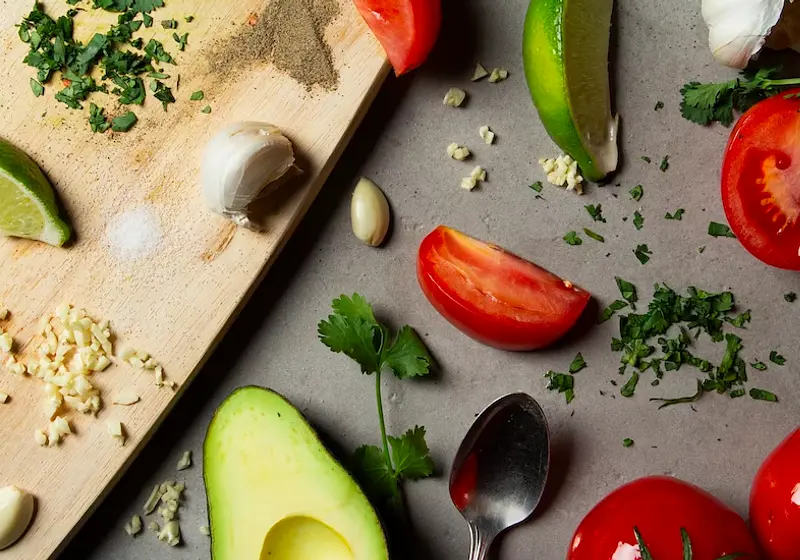What is Meal Prepping?
Meal Prepping is the making of food ahead of schedule, and is usually done in large batches. By making food ahead of time, you have to consciously decide what to make, which can often help improve food awareness and health. Meal prepping can also be cheaper, as you only shop for exactly what you need, and food almost never goes to waste.
As school is starting, along with packed lunches and rushed mornings, consider trying meal prepping, as it can save you time and energy. Even if half your lunches are prepped, you still gain time and can make more conscious decisions about your diet.

Photo by Ella Olsson from Pexels
Let us slide into your dms 🥰
Get notified of top trending articles like this one every week! (we won't spam you)Ways of Meal Prepping
Batch Cooking: Batch cooking entails doubling a recipe and making enough for 1-2 weeks. The food is transferred into portion-sized containers, and heated when ready for use. If you decide to batch cook, choose a day to prepare, cook and portion everything.
This is usually done on Wednesday or Sunday, but I would definitely recommend Sunday, as many won't have the time during the week. To add more variety, you just make 2 different recipes, instead of doubling one.
Pros: More affordable, easy, less wasteful, pre-portioned, lasts longer.
Cons: Potentially less variety.

Photo by Conscious Design on Unsplash
Make-Ahead Meals: Similar to batch cooking, make-ahead meals are made beforehand, and the entire batch is kept in the fridge or freezer. For example: Making lasagna and keeping the whole pan covered in the fridge until use.
Pros: Easy, lasts longer.
Cons: Less affordable, only feeds for 1 or 2 meals.
Pre-prepping ingredients and fresh food: This form of meal prepping involves washing, cutting, seasoning and potentially cooking certain ingredients, then storing them in Tupperware until the meal is made. When your ready to make the meal, it is quicker since you don't need to prep.
Pros: Easy and quick to prep.
Cons: Doesn't really reduce time spent cooking.
Which one is best for students?
When taking time, effort and price into account, as well as teenage routine, batch cooking is the best way for students to meal prep. This is because it can be done easily on one day, and can last for the rest of the school week. It is also pre-portioned, so acts as a grab and go meal on early mornings. Although you try out the other methods and see what works best for you, I would suggest batching cooking more often than anything else.

Take the Quiz: What Ramen Are You?
There are sooo many pre-packaged Ramen brands out there. Which one should you try/best fits your personality?
Storage Solutions
- Rubbermaid 8-piece Glass Food Containers with Lids set
- Pyrex 18-Piece Clear Store Food Storage Set, Circular and Rectangular
- 3 piece Nesting Silicone Food Containers - Grey
- 20 Piece Large Plastic Food Storage Container with lid,
- 32 oz Wide Mouth Mason Jars - 6 piece
Beware of Food Safety Issues

As the majority of food prep requires cooking food, letting it cool and then reheating it at a later date, one must be aware of food safety. If not, it may lead to food waste or food poisoning.
Checking Expiry Dates: When meal prepping, check if the recipe specifies how long the food will last in the fridge/freezer. If it doesn't provide a date, Google how long the dish lasts and check a couple of sources to find a common length of time. Once you know the expiry date, place a label or strip of tape with the date onto your containers. If you meal prep more then one recipe, priorize eating the one that goes off first, to reduce waste.
Cooling: When letting food cool down, do not let it sit out for more then an hour as it allows bacteria to grow rapidly, therefore spoiling the food.
Reheating: If your meal requires reheating, whether its in the oven, microwave or on the stove, make sure the food is hot throughout before consuming it. This may require reheating for longer than a recipe states, as under-cooking food can lead to food poisoning.

Photo by Ella Olsson on Unsplash
What meals should students meal prep?
As mornings can be rushed, it is best to prep breakfast and lunch. While lunch is the more important meal, making quick healthy breakfasts can help reduce stress in the mornings and can give you extra time.
When meal prepping lunches, you can also meal prep snacks, like fruits or vegetables, by washing, cutting and seasoning them. Keep these snacks in silicon snack bags and enjoy!

Ideas and Recipes
Breakfast
sandwiches
These savory, protein-packed breakfast sandwiches are customizable and so easy to prep. Make enough to last a week or two and store in the freezer for a delicious breakfast!
To make 6 sandwiches, whisk together 8 large eggs, 3 tablespoons of milk, salt, pepper and any other veggies you wish to add. I would suggest adding chopped spinach and chopped cherry tomatoes. Pour the mixture into a large greased baking dish and cook at 350 for 12-15 minutes, or until just set.
Cut the egg into 6 squares and place on the bottom half of an untoasted bagel or English muffin. Top with protein and a slice of cheese (optional), and the top half of your bagel or English muffin. Wrap your sandwich in tinfoil and keep in the freezer until use. These keep for up to a month in the freezer. A day or two before use, move the sandwiches to the fridge to defrost, then cook at 350 for 10-12 minutes, flipping at half time.
Chia pudding
Make chia pudding by adding 1 tablespoon of chia seeds to every 1/4 of milk (In order to make enough for one school week, combine 5 tablespoons of chia and 1 & 1/4 cup of milk) and mix until combined. Add 1 teaspoon of honey or maple syrup and leave in a bowl or jar overnight (or until used). If your pudding is too thin, you can add an additional teaspoon of chia seeds until thickened. You can top this with granola, fresh berries or jam.

Photo by Ash Edmonds on Unsplash
Overnight oats
This simple and filling breakfast can come together in a number of minutes and can be topped however you like. Make five servings on Sunday and you'll have breakfast every day of the week. Overnight oats keep in the fridge for five days.
Just add half a cup of your milk of choice, half a cup of rolled oats, 1 tablespoon of chia seeds and 1/2 teaspoon of vanilla extract to a mason jar and refrigerate overnight (or until used). When ready to eat, add toppings and either microwave until warm or eat cold. I suggest serving with granola, coconut flakes, honey, berries, fruit, nut butter, nuts or spices.
@kalejunkie Here are my tips for making the best overnight oats! #overnightoats #howto #mealprep #sustainability ♬ original sound - Nicole K. Modic
Pancakes
While pancakes are usually a weekend treat, this method of freezing pre-made pancake batter and toppings can make mornings so much fun! You can use pretty much any pancake batter (even from a mix), just adding berries, fruits or chocolate chips and freezing in an ice-cube tray. When you want to make them, just add a couple of cubes to a pan or griddle and cook on medium until golden.
Lunch
Salad jars

Photo by Mariana Medvedeva on Unsplash
For a refreshing and easy lunch, try making salad jars. They can be made with anything lying around the house, and last longer than a regular salad, due to the specific layering of ingredients and the jar shape. If you don't have any mason jars, you can use any tall container that has a lid.
For the perfect salad jar, start with your dressing or sauce at the bottom, then your protein, then add chopped veggies and either greens or grains and top with herbs or seeds. This formula can help you create the perfect lunches, which can last up to 5 days in the fridge. If you don't know where to start and need some inspiration, below are three salad jar recipes for you try!
Peanut Salad Jar
Sauce: Peanut butter, maple syrup, soy sauce, lime juice and water
Protein: Tofu
Veggies: Shredded carrots, shredded purple cabbage, edamame beans and cilantro
Grains: Rice, noodles or quinoa
Toppings: Chopped green onions and crushed peanuts
Greek Salad Jar
Sauce: Olive oil, lemon juice, salt & pepper and (optional) Dijon mustard
Protein: Chickpeas
Veggies: Cucumber, cherry tomatoes and red onion
Grains: Quinoa
Greens: Chopped romaine lettuce
Toppings: Feta cheese
Caprese Salad Jar
Sauce: Olive oil and balsamic vinegar (2:1 ratio)
Protein: Chopped mozzarella or bocconcini
Veggies: Cherry tomatoes
Grains: Cooked short pasta like macaroni, cavatappi or shells
Greens: Basil and spinach or argula
Mason Jar soup
Similar to mason jar salads, these soups are an easy way to use up veggies, and can be so great to eat in the colder months. When making your soup jar, start with your broth or base, then add protein, veggies, greens, grains and toppings. When ready to eat, simply pour boiled water into the jar, seal it and wait 5 -7 minutes.
Both veggies and greens can be frozen, as they will defrost with the boiled water. You can eat from the jar or transfer into a bowl. Below are a few ideas for soup jars to try out.
Important: Bring jar to room temperature before adding hot water, as adding heat to cold glass could cause your jar to shatter!
Miso Soup Jar
Base: Miso paste, soy sauce, sesame oil and grated or powered ginger.
Protein: Tofu
Greens: Spinach or wakame seaweed
Grains: Vermicelli or rice noodles (optional)
Toppings: Finely chopped green onions, black sesame seeds
Noodle Soup Jar
Base: Soy sauce, sesame oil, grated ginger & garlic and veggie or chicken broth paste.
Protein: Your choice!
Greens: Bok choky and grated carrots
Grains: Rice noodles
Toppings: Green onions
Peanut Seasame Soup Jar
Base: Veggie or chicken broth paste, sesame oil, peanut butter, soy sauce and (optional) tahinix
Protein: Tofu
Veggies: Purple cabbage, shredded carrots and edamame beans
Greens: Bok choy or spinach
Grains: Rice noodles
Toppings: Green onions and crushed peanuts
Final Thoughts
I encourage you to give meal prepping a try, even if you only prep 2 or 3 of your meals each week! In all honesty, you don't even need large sets of Tupperware, you can just try it out with what you have. If it works for you, then start prepping more meals beforehand and try to find ways of prepping your favorite foods & recipes.
For students, mornings can be difficult and having a quick breakfast or a grab & go lunch can help reduce stress, and maybe even buy you 10 more minutes of sleep!
















